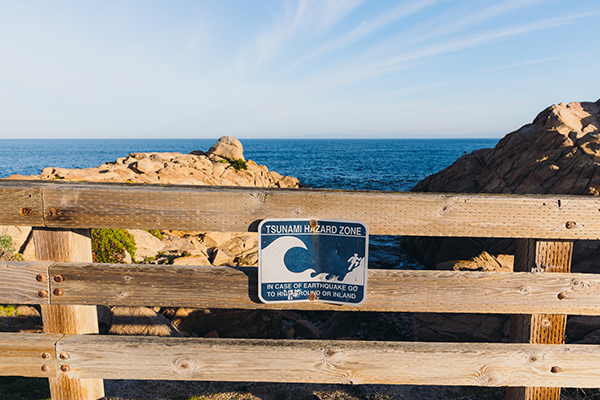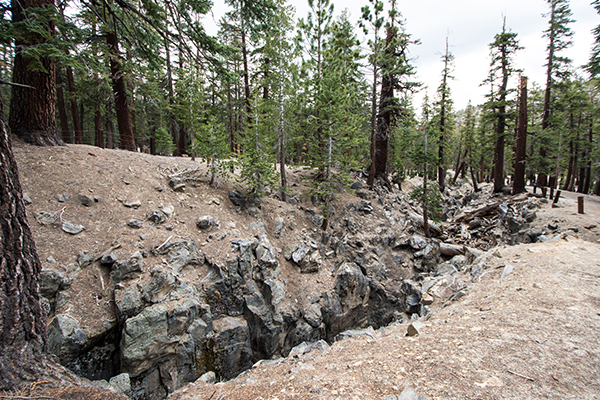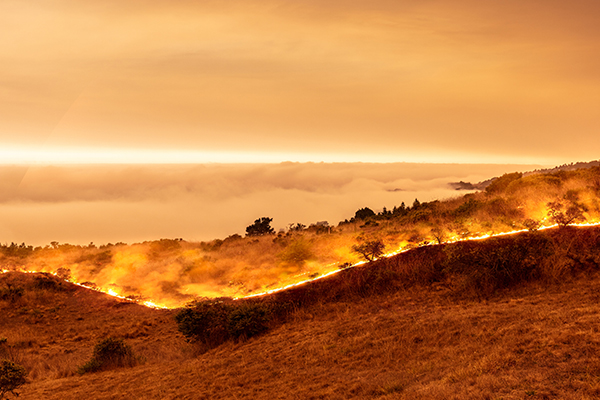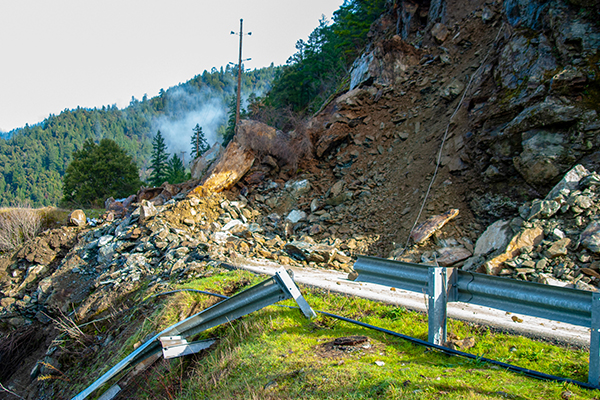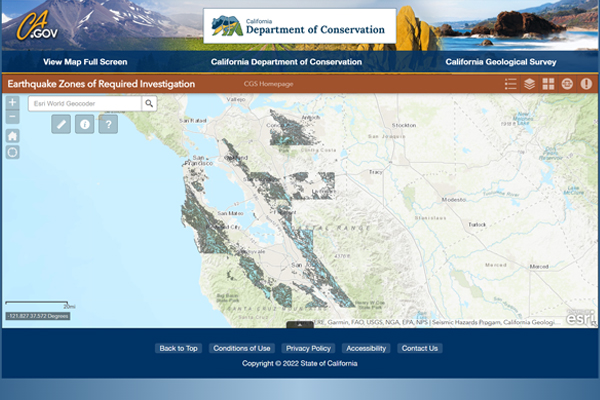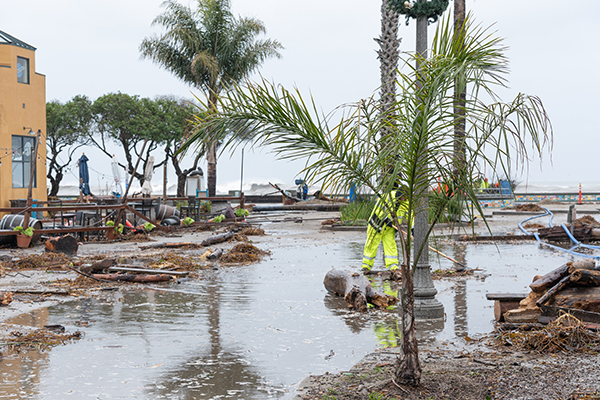What is a Natural Disaster?
According to the U.S. Department of Homeland Security, “natural disasters… have the potential to pose a significant threat to human health and safety, property, critical infrastructure, and homeland security.” Natural disasters can occur seasonally or suddenly and may cause property damage, loss of life, and disruption of communities and natural ecosystems.
Examples of common natural disasters that occur in California include earthquakes, wildfires, landslides, and floods. California sometimes even experiences tornadoes and hurricanes. According to the USGS, California is even home to active volcanoes!
Why is California Prone to Natural Disasters?
California experiences many natural disasters, but why? One reason is because of its location along the Pacific Ring of Fire, which increases the chance of earthquakes. 15,700 earthquake faults run through the state of California, including more than 500 faults that are categorized as “active.” These faults lead to a great deal of seismic activity, making California the second most seismically active state.
But while California is famous for earthquakes, other natural disasters are also common in the Golden State.
California Earthquakes
California is especially prone to earthquakes. This is in part due to its location along the Pacific Ring of Fire, where large tectonic plates converge. The state is also home to major earthquake faults, including the infamous San Andreas fault and Hayward fault, which have each played significant roles in California’s seismic history.
Due to California’s many faults, earthquakes frequently occur throughout the state. But of course, they’re particularly impactful when they hit the state’s largest urban areas, such as the San Francisco Bay Area, Los Angeles and San Diego.
Earthquakes cause damage primarily by shaking the ground, which can cause buildings to fall and power lines to topple. Major earthquakes can cause a great deal of damage, and even threaten lives.
No one can predict when the next earthquake will strike, but you can strengthen your home and help protect your family from earthquake damage with a seismic retrofit. Your home may be especially vulnerable if it was built before 1980. Learn more about the different kinds of retrofits by visiting our Strengthen Your House page.
Noteworthy Events in California's Seismic History
California has a long and storied seismic history, with earthquakes documented as early as the 1600s. And although most of California’s earthquakes are too small to be felt by people, the state has seen several major earthquakes, including:
- The M7.9 Great San Francisco Earthquake (April 1906): One of the biggest natural disasters in California’s history, this earthquake started devastating fires that lasted for days, causing $8.08 billion dollars in damage, killing as many 3,000 people, and destroying more than 80% of the city of San Francisco.
- The M6.9 Loma Prieta Earthquake (October 1989): This gigantic earthquake struck on the San Andreas fault, causing $10 billion in damage, destroying 963 homes and 147 businesses, injuring 3,757 people, displacing 12,053 people, and costing 63 lives. The famous image from this earthquake was the collapsed Cypress Structure section of Interstate 880 in Oakland.
- The M6.7 Northridge earthquake (January 1994): This earthquake damaged or destroyed thousands of homes and displaced about 22,000 people. The Northridge earthquake is regarded as one of the most expensive natural disasters in the history of the United States, causing an estimated $20 billion in residential damage alone.
Major earthquakes are not only a thing of the past in California. Scientists warn that the earthquake risk is ongoing, and remains quite high. According to the latest research from USGS, published in 2015, there is more than a 99 percent chance that one or more major earthquakes will strike California in the next 30 years.*
To protect yourself, your family and your home from the next big earthquake, view our Guide to California Earthquake Preparedness, read our top-rated earthquake safety tips, create your own earthquake emergency kit, and consider getting an earthquake retrofit done on your house.
Wildfires
Wildfires are another major natural disaster that California experiences regularly. The New York Times explains that California is especially prone to wildfires, in part because of these risk factors:
- Its climate, which includes wet falls and winters, but dry summers. This combination provides a great deal of dry vegetation that can become kindling for major fires.
- Its high population, which contributes to the risk of accidentally sparking wildfires due to various human activities.
- The Santa Ana winds, which are strong gusts that contribute to the creation of two distinct fire seasons in California.
A recent report from the California Office of Environmental Health Hazard Assessment (OEHHA) explains “California’s exponential increase in wildfires” as being due to a “hotter, drier environment driven by megadrought.” And researchers from the Scripps Institute of Oceanography have predicted that the “number of wildfires could grow significantly over the next 40 years,” with “warmer summer temperatures and climate-driven aridity [fueling] more wildfires.”
Notable Wildfires in California History
The Western Fire Chiefs Association recently published an infographic containing details about California’s most destructive wildfires, including:
- The August Complex Fire (August 2020): This is the largest wildfire on record in California, which burned through 1,032,648 acres in Mendocino County. This fire was so large that it had to be managed as four separate incidents within a larger complex.
- The Dixie Fire (July 2021): The second largest wildfire in the state’s history, this fire burned 963,309 acres in Butte County, destroying several communities, including Greenville, Canyondam, and Warner Valley.
- The Mendocino Complex Fire (July 2018): The third largest wildfire in California history, this burned 459,123 acres in Colusa County, lasting for more than three months, destroying 280 structures, and causing at least $257 million in damages.
View the CAL FIRE Fire Hazard Severity Zone Map to find out about your local risk of wildfires, and get tips on how to prepare for them.
Landslides & Mudslides
According to the California Department of Public Health, “landslides are caused by disturbances in the natural stability of a slope,” which can happen after heavy rain, droughts, earthquakes and even volcanic eruptions.
California’s wildfires also make parts of the state “susceptible to landslides, mudslides, and mudflows as a result of the landscape changes.” When fires burn trees and vegetation, the ash and debris resulting from the fire can make the ground slick, increasing the risk of landslides.
Landslides and mudslides can become a major disaster when large amounts of material move quickly, destroying homes, blocking roads, and threatening lives. When California experiences large winter storms that bring heavy rain, it’s important to pay close attention to the increased risk of landslides and mudslides.
Notable Landslides in California History
- Portuguese Bend Landslide (1956 - present): This ongoing landslide in the Portuguese Bend area near Los Angeles has caused substantial damage to homes and infrastructure over the decades. It is one of the most well-documented and studied landslides in California, providing valuable insights into long-term slope movements.
- Mammoth Lakes Landslide (May 1980): The Mammoth Lakes region in Northern California’s Eastern Sierras experienced large-scale landslides in May 1980, following the eruption of Mount St. Helens volcano. These events were linked to underground magma movement, leading to ground deformation and infrastructure damage.
- La Conchita Landslide (December 2004 – January 2005): Triggered by heavy rain, a massive debris flow swept through the coastal community of La Conchita in Ventura County, causing significant destruction and claiming ten lives.
To learn about your local landslide risk, view the California Geological Survey map, which reports local risks for major metropolitan areas throughout the state. To view your local landslide risk:
Visit the California Geological Survey Earthquake Zones map
- Click on the hamburger “Layer” list on the top right
- Turn off all layers except “CGS Landslide Zones”
- Move the map to your local area to check your local risk
Find out how to protect yourself and your family from landslides by visiting the USGS website, where you can learn about their early warning signs, and read about what to do before, during, and after a landslide.
Floods
The California Department of Water Resources explains that “California is prone to potentially devastating impacts of period floods.” They report that all California counties have experienced at least one significant flooding event over the past 25 years, leading to billions of dollars in damage and significant loss of life.
Notable Floods in California History
California has experienced many major floods, including:
- California’s Great Flood (December 1861 – January 1862): The largest flood in California’s recorded history, which lasted for 45 days. This flood completely inundated the entire Sacramento and San Joaquin valleys for 300 miles, averaging 20 miles wide. Extensive rain in Southern California turned Orange County into an inland sea, with water standing about 4 feet deep up to 4 miles from the river, and lasting about three weeks.
- The Los Angeles Flood of 1938 (February – March 1938): This was one of Southern California’s largest floods, caused by two storms that caused nearly a year’s worth of rain over just a couple of days. Around 115 people were killed by the flooding, which caused $78 million in damage, making it one of Los Angeles’s most expensive natural disasters of all time.
- The Oroville Dam Spillway Failures (February 2017): This was caused by a combination of heavy rains and damage to the dam’s main spillway, which had to be stopped to assess for damage and consider next steps. While the dam experienced significant damage, fortunately, no major collapse occurred, but this event serves as a warning sign that California, the state widely and most commonly known for major earthquakes and wildfires, still faces a high risk of water-based natural disasters.
The California Department of Water Resources works to mitigate the risk of catastrophic floods in various ways. Find out how to protect your family from floods by visiting their webpage on flood preparedness.
How to Prepare for California’s Natural Disasters
Our state is at risk for several other types of natural disasters too, including drought, tsunamis, and severe coastal erosion. Because these natural disasters can strike at any time, it’s important to be prepared. The best way to protect your home and your family from California’s natural disasters is to start your preparations well before the disaster strikes.
California’s Office of Emergency Services monitors the warning signs of natural disasters and organizes the state’s preparation and response efforts. We recommend signing up for their wireless emergency alerts, visiting their website and reviewing the information shared in the “Be Ready” section for details on how to prepare for each of California’s most common natural disasters.
For more tips, advice and information about earthquakes, be sure to visit our Seismic Strong Blog.
*According to the third Uniform California Earthquake Rupture Forecast (UCERF3) report.

